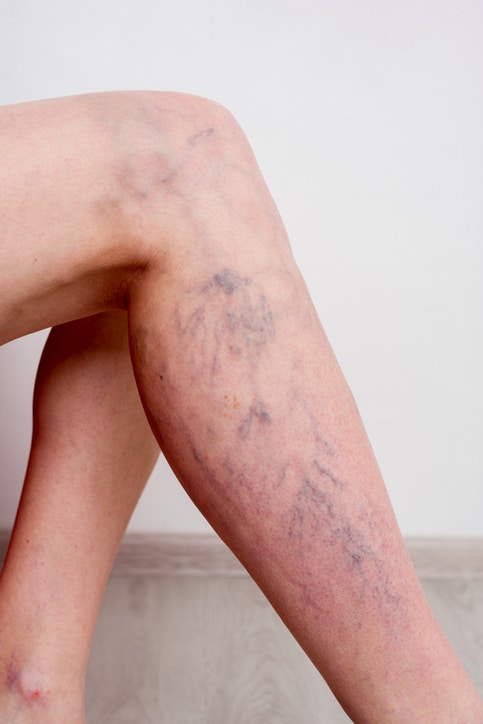
An ambulatory phlebectomy, also called a microphlebectomy or stab phlebectomy, is an outpatient procedure performed to remove spider and varicose veins through small, slit-like incisions in the skin. When varicose veins near the surface of the skin are too large to treat with sclerotherapy and too small to treat with laser ablation, microphlebectomy is the preferred treatment. Since veins are extremely collapsible, even the largest affected veins can often be removed through tiny incisions using the ambulatory phlebectomy procedure. This minimally invasive treatment does not require sutures or general anesthesia and can easily be performed in the doctor’s office with minimal downtime. Ambulatory phlebectomy involves less pain and fewer risks than traditional surgical treatment.
Who Is A Candidate For Phlebectomy?
Ambulatory phlebectomy may be needed when a person is suffering complications from varicose veins, such as persistent pain, cramping, or discoloration of the skin. Nearly anyone who is bothered by the appearance of or symptoms of varicose veins may consider this procedure. A vein specialist conducts a thorough consultation to help determine which treatment options are suitable for each person based on their medical history and current situation. Ambulatory phlebectomy may not be recommended for people taking blood-thinning medications, people with clotting issues, or who have cellulitis or severe edema in the same area as varicose veins.

Reasons For Ambulatory Phlebectomy
Some patients seek treatment for their varicose veins for cosmetic purposes, while others are concerned about the potential risks of their damaged veins. Untreated veins can lead to pain, inflammation, and discoloration. They can also affect the flow of oxygen-depleted blood between the lower legs and the heart. Ambulatory phlebectomy treats symptomatic and asymptomatic veins and can relieve both cosmetic and medical concerns in one simple procedure. After damaged veins have been removed, other healthy veins in the leg will absorb the excess blood and reinstate a normal blood flow. The functioning will not be affected by removing the damaged veins, as there are many surrounding veins to take over.
How do I prepare for my ambulatory phlebectomy?
There really isn’t any preparation necessary for these procedures. You’ll need to wear compression stockings afterwards for one week, so you’ll want to purchase these beforehand. We’ll prescribe a muscle relaxant that you’ll need to take before your procedure. Since only local anesthesia is necessary, you don’t have to worry about fasting prior to your treatment. Because you had a muscle relaxant, you’ll need someone to drive you home from your treatment.
Ambulatory Phlebectomy Procedure
The ambulatory phlebectomy procedure is performed on an outpatient basis. This procedure takes about 45 to 60 minutes to perform. The doctor will first identify the veins to be treated to ensure precise removal and to help preserve the health of surrounding veins and tissue. Before beginning the surgery, the doctor will inject a local anesthetic into the skin. Patients generally do not experience any discomfort during the procedure. Tiny incisions will be made in the targeted areas, and a surgical hook will be inserted to extract the damaged veins section by section. The incisions are very small and frequently no stitches are required. Veins are very collapsible such that even large veins may be removed through the tiny incisions used in this technique.
Will I Need An Examination Prior To A Phlebectomy?
Before undergoing ambulatory phlebectomy, patients have a comprehensive consultation and examination with a vein specialist. This visit explores the severity of the varicose veins and may consider the merit of other treatments, such as sclerotherapy, to improve appearance and comfort. If ambulatory phlebectomy is needed, the doctor explains the details of the procedure to the patient and provides the necessary information to plan for treatment.
Recovery From Ambulatory Phlebectomy
Some bruising, discomfort, and swelling are to be expected after an ambulatory phlebectomy. Swelling and pain can be minimized with compression garments and over-the-counter pain medications, and are usually only temporary. Patients will be able to walk and carry on with normal activities immediately after the ambulatory phlebectomy procedure, though they will have to wear compression stockings for the first week. They can usually return to work the next day, although exercise and heavy lifting should be avoided for about two weeks.

The incisions from this procedure do not require sutures and are able to heal on their own, and are often barely visible after six to twelve months. Some patients may experience mild skin pigmentation at the site of the varicose vein, but this usually goes away on its own after a short time. Most people see effective results from an ambulatory phlebectomy since damaged veins have been completed removed. Ambulatory phlebectomy offers permanent effective results for most patients, although it is possible for new varicose veins to develop, particularly in patients with a family history of varicose veins. The risk of recurrence can be minimized if the patient maintains a proper weight and an active lifestyle.
Should I Expect Scarring After A Phlebectomy?
No. Unless you have a history of keloids, which are thick, raised scars, your incisions should heal to a point of near invisibility. The incisions are very short and usually heal within a few days. If you are concerned about visible marks on the skin, you may apply a topical scar cream once your skin has closed completely.
Can Veins Come Back After Having A Phlebectomy?
Unfortunately, varicose veins can be a chronic condition. While existing visible veins can be treated with ambulatory phlebectomy and will not grow back, there is no way to predict whether other veins will eventually lose proper function. Due to the nature of venous insufficiency, other veins may likely start to swell in the future.
Will I Need Stitches After A Phlebectomy?
Probably not. The incisions for ambulatory phlebectomy are very small and are usually able to heal on their own without stitches. After the procedure, the doctor will place a small bandage over the incision or incisions to protect the skin as it heals.
Is Phlebectomy Painful?
When a MIVC doctor describes the procedure during your consultation, many patients tell us it sounds quite painful. Reality tells a different tale. Prior to working on any vein, your MIVC doctor injects the area with local anesthetic. This numbs the skin across the vein and keeps you from feeling the small incisions or the insertion of the hook to grab the poorly functioning vein. While our blood vessels don’t have any nerves, the surrounding skin certainly does. But the local anesthetic keeps you comfortable.
Afterwards, you may have some soreness, but it’s easily handled with over-the-counter pain medication. The lack of pain or any noticeable recovery is far different from the old method of surgically removing varicose veins, vein stripping.
Risks Of Ambulatory Phlebectomy
Although an ambulatory phlebectomy is considered quite safe, there are certain risks associated with any surgical procedure. In a few cases, there may be residual inflammation and irritation resulting from incomplete removal of damaged veins. Other risks may include:
- A nerve injury to the skin
- Adverse reaction to anesthetic or sedative
- Severe bleeding or swelling
- Numbness or pain in the feet
- Post-surgical infection
- Thrombophlebitis
Patients who are allergic to local anesthesia or those who cannot wear compression stockings should not undergo the ambulatory phlebectomy procedure. Any active infections or rashes should be thoroughly treated before this procedure as well.
Is there aftercare necessary after an ambulatory phlebectomy?
These are relatively simple procedures with little recovery. Really the only thing you need to do afterwards is to wear your compression stockings. You’ll need to wear these for up to two weeks, depending upon the vein or veins removed. The compression helps push blood up through the veins. This is especially important in the days after your phlebectomy when the blood from the damaged vein is being re-routed to a new set of healthy vessels. Compression makes this process proceed more smoothly.
Will I need to have another microphlebectomy performed in the future?
Your MIVC doctor removes the targeted vein, and it won’t be returning. But the conditions that caused your vein to weaken and transform into a curly varicose vein are likely still present. That means you could develop other varicose veins in the future. The treated vein is gone for good, though.
Also, if you take some steps (literally) to get up and about more, you can help to prevent future varicose veins. We’ll talk with you about the best ways to strengthen your circulation in your legs.
When can I get back to my normal activities after having ambulatory phlebectomy?
Amazingly, you can walk the same day as your treatment and immediately return to normal activities. You’ll want to keep your legs moving, but you also don’t want to overdo things. You can use an elliptical, walk more, or ride a bike within two days, in most cases. You should hold off on strenuous exercise and any moderate to heavy lifting for two weeks. Patients usually return to work the next day.

Will my health insurance cover an ambulatory phlebectomy?
Most insurance providers, along with Medicare, cover these procedures; they are not deemed elective. Plus, compared with vein stripping surgery, these methods are much easier on the patient, which is easier on the insurance company. The costs of your compression hose may or may not be covered, but their cost is small.
Schedule Your Consultation Today
If you’re interested in learning more about ambulatory phlebectomy please contact us for a consultation at (855) 803-6482 or fill out our contact us form. We will discuss your needs and concerns, and determine your best course of action.


Monday – Thursday: 9am – 5pm
Friday: 9am – 1pm
Saturday – Sunday: Closed